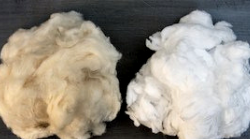When considering the type of cotton to be used in applications such as nonwovens going into hygiene products, there are several considerations including the use of purified cotton or mechanically cleaned and sterilized cotton.
While purified cotton going into hygiene products is mechanically cleaned much like nonpurified cotton, that’s where the similarities end. Let’s take a look at some of the important differences between cotton that has been prepared via purification vs. sterilization.
Creating Absorbency and Color
After mechanical cleaning, purified cotton also undergoes intense wet processing to remove the oils and waxes that are on the cotton as it grows naturally in the fields. Also, raw cotton is greyish in color. By removing the oils and waxes, cotton becomes pure cellulose and absorbent. Additionally, the cotton is whitened with gentle hydrogen peroxide so that the final fiber is ultra-white, as consumers have come to expect. The purified cotton then passes United States or European Pharmacopeia for purity and is acceptable for medical, pharmaceutical and hygiene applications.
In contrast, mechanically cleaned and sterilized cotton is nonabsorbent and still of a grayish color, as the oils and waxes still reside on the cotton.
Dealing with GMOs and Contaminants
Although cotton is not ingested, some people are concerned that the predominant cotton grown in the US and globally is grown from GMO seed. However, during the purification process, the DNA marker for GMO is completely erased.
While the cotton plant is growing prior to harvest, herbicides, pesticides and fertilizers are commonly used, as with most agricultural products, to manage healthy growth of the plant. During the purification process, any residual chemicals from the growing cycle are removed. This is not true for mechanically cleaned and sterilized cotton.
Sterilization
Cotton has long been a staple for medical and dental application, and each of these markets have regulatory compliance standards for fiber purity. Purified cotton has long been recognized as the appropriate fiber for these applications, due to its purity as only pure cellulose remains following purification. Mechanically cleaned cotton that has been sterilized eliminates microorganisms such as bacteria and fungi but all the other elements of the cotton fiber remain.
One note of caution: many sterilization methods will involve sterilizing the cotton in bale form. Once the bale is opened for further processing, it can become nonsterile and may require re-sterilization.
OSHA’s Cotton Dust Standard
Nonwoven converters using mechanically cleaned and sterilized cotton must meet US Occupational Safety and Health Administration (OSHA) dust level standards. To meet OSHA’s cotton dust standard requirements, manufacturing facilities must periodically submit air samples to test the amount of dust present. In addition, nonwoven converters using mechanically cleaned and sterilized cotton must also be concerned with health issues of their employees. OSHA requirements in this regard include subjecting all workers in the plant area to annual medical respiratory exams. Proper documentation must be kept on both dust level measurements and these required employee health checks.
Purified cotton is exempt from OSHA’s dust regulation. The purification process removes the health risks that are associated with non-purified cotton and sterilized non-purified cotton.
To learn more about the cotton purification process, a more sophisticated way to achieve superior results for color, performance, and cleanliness, visit www.purifiedcotton.com, or click here to contact Barnhardt Purified Cotton®.
